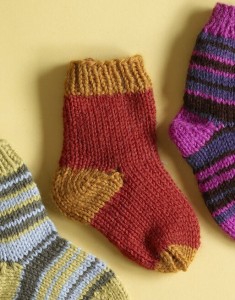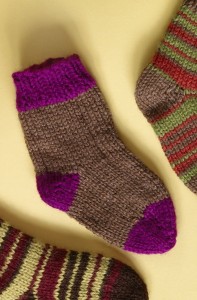Why are socks so popular to make right now? Socks are a great easy-to-carry project and they’re compact and satisfying to make. Over the next few months, we will be showing you different ways to embellish your sock patterns. In our first installment, we featured a basic, solid kids’ sock. In this article, we feature a two-color sock.
 |
 |
 |
| Child’s Two-Color Sock #1 | Child’s Two-Color Sock #2 | Child’s Two-Color Sock #3 |
Color adds so much to your wardrobe. It also says so much about your personality. Adding color to the heel, toe, and cuff of this sock pattern is a simple way to make your basic sock more exciting. This simple concept of adding color to a few details of a project can be applied to any item. Make your color and cuffs a different color the next time you make a jacket or make the strap of your next bag or purse a contrasting color. Let your imagination run wild.
But how do you pick colors that will work well together? Here are some tips:
No matter what the project is, big or small, a little color can go a long way. Remember, don’t be afraid to experiment and choose colors you (or your loved ones) will love.
—
A version of this article first ran in The Weekly Stitch newsletter. Click here to sign up for the newsletter and get articles, free patterns, and exclusive offers in your inbox each week.
You must be <a href="https://blog.lionbrand.com/wp-login.php?redirect_to=https%3A%2F%2Fblog.lionbrand.com%2Fsock-tips-pt-2-knit-charming-two-tone-socks%2F">logged in</a> to post a comment.
4 Tips on Knitting Striped Socks (and Other Projects) | Lion Brand Notebook
[…] to add color and pattern to a basic child’s sock. Click here for part 1 and click here for part 2. This month’s article is all about […]
GrannyD
I hate to be a nay-sayer but the picture shows socks with very little turn in the heel resulting in the sock heel sliding down off the kid heel. I’ve been knitting socks for years and most kids and adults too would rather have a “store-bought” sock than a baggy one that doesn’t hug their heel. I’m just saying.